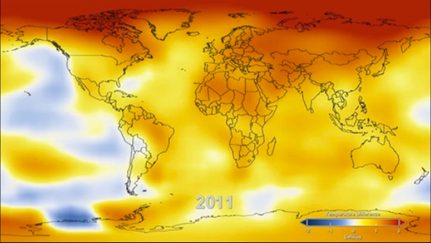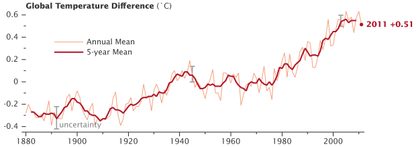SUMMARY
This is AI generated summarization, which may have errors. For context, always refer to the full article.

MANILA, Philippines – Did you feel like 2011 was a really hot year? Science agrees with you.
A US National Aeronautics and Space Administration (NASA) report, released last Thursday, January 19, found that 2011 was the 9th warmest year on record since 1880.
NASA’s Goddard Institute for Space Studies (GISS) compared global surface temperatures for the past year to those from the mid-20th century, and it showed how the Earth “continues to experience warmer temperatures than several decades ago.”
“The average temperature around the globe in 2011 was 0.92°F (0.51°C) warmer than the mid-20th century baseline,” the GISS said in a press release.
The year 1880 is used as a starting point, the agency said, since it was when instrumental records were first kept.
35th year of above-average temps
Another climate study, this time by the US National Oceanic and Atmospheric Administration (NOAA) National Climatic Data Center, stated that 2011 was the 35th consecutive year, since 1976, that the yearly global temperature was above the average, pegged at 16.1°C (60.9°F).
Only 1998 was warmer than 2011, the NOAA noted. The warmest years on record were 2010 and 2005, a virtual tie.
This was despite the presence of La Niña, which the NOAA noted was present during most of 2011. “When compared to previous La Niña years, the 2011 global surface temperature was the warmest observed during such a year,” it noted.
The GISS report also cited that the presence of La Niña lowered global temperatures a bit.
2011 was very wet, too
The NOAA report said warmer-than-average temperatures were recorded for most of the world’s surface, especialy in parts of the Northern Hemisphere.
Some areas, meanwhile, such as parts of the United States and Australia, had below normal temperatures.
Precipitation over land was also above average for the second year in a row, also ranking 2011 as the second wettest year on record, behind 2010.
Despite this, some areas experienced intense drought, in particular parts of Mexico, the US, and in East Africa.
A hot decade, too
The past decade has been hotter, too: the first 11 years of the 21st century (2000-2011) “experienced notably higher temperatures compared to the middle and late 20th century,” noted GISS director James Hansen.
“The only year from the 20th century in the top 10 warmest years on record is 1998,” the GISS said.

Also, a 5-year running mean global temperature shows a possible slowing down in the increase of temperatures, but the GISS said this is “likely to prove illusory.”
What could be the reason for this? The GISS said these higher global temperatures are being driven by higher amounts of greenhouse gases in the atmosphere, carbon dioxide in particular, trapping the planet’s infrared radiation rather than allowing it to escape to space.
“The carbon dioxide level in the atmosphere was about 285 parts per million in 1880, when the GISS global temperature record begins. By 1960, the average concentration had risen to about 315 parts per million. Today it exceeds 390 parts per million and continues to rise at an accelerating pace,” the report noted.
Higher temps?
GISS’s Hansen, meanwhile, said he sees “record-breaking” global average temperatures in the next two or three years, citing heightened solar activity and a possible El Niño in the horizon.
“It won’t take a very strong El Niño to push temperatures above 2010,” Hansen was quoted as saying.
NASA’s GISS said their temperature analysis is compiled from weather data from more than 1,000 meteorological stations globally, satellite records, and Antarctic research station data.
Read more about the NASA GISS report here, and the NOAA report here. – Rappler.com
Add a comment
How does this make you feel?
There are no comments yet. Add your comment to start the conversation.